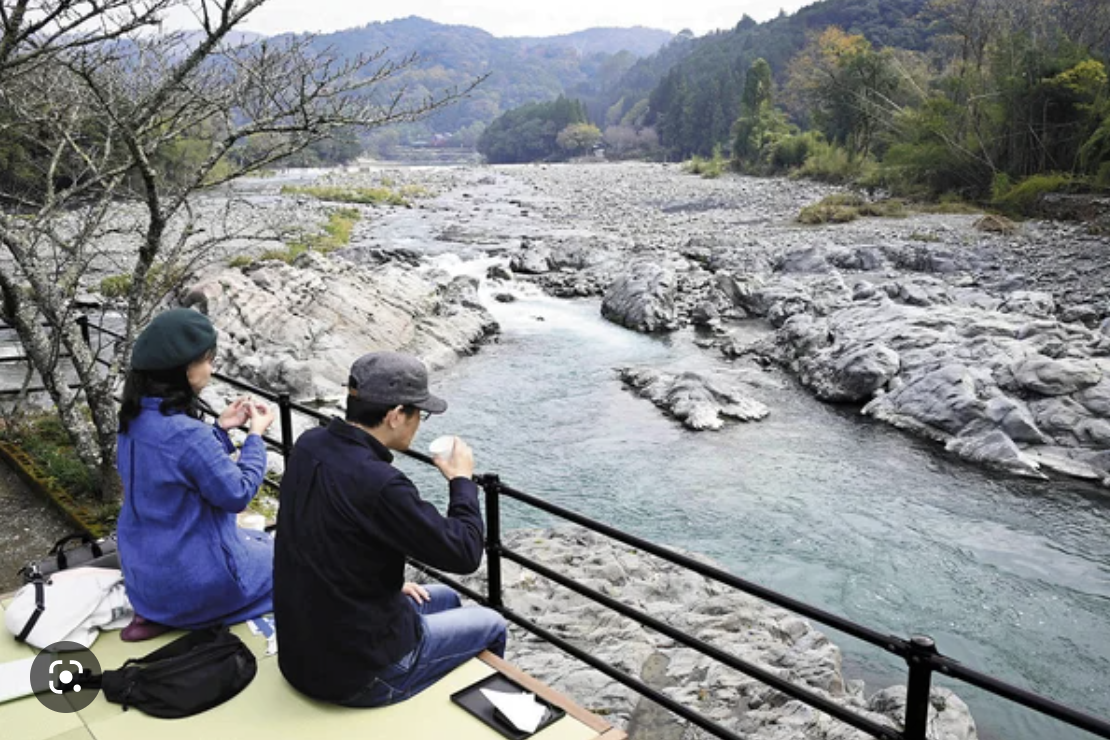December marks the end of the year. Demand for loose leaf tea in Japan has been going down for a while and this year has been no exception. This propelled people in the tea industry to look for ways to create value beyond the tea leaves themselves. A tea farm in Shizuoka installed solar panels above their tea fields and the sold electricity has been generating about 10% of the revenue. With a plan to install storage batteries, they are aiming to switch all their factory usage to renewable energy next year.
Tourism is another way to generate additional value from tea. A young company in Shizuoka AOBEAT is bringing visitors to scenic terraces set up in tea farms all around the prefecture to enjoy local tea. Sagara in Kumamoto, which has suffered from flooding, has created a portable tea room and sauna in front of Kawara River to promote tourism as part of the village recovery plans.
Innovation is growing among the tea and teaware products too. Aiming to revitalize local brand Ureshinocha, Saga prefecture has started the “Green Letter Project” where tea from the prefecture can be sent as a letter to family and friends. Iruma city in Saitama has been collaborating with students from Tokyo university in creating cinnamon-flavored Japanese teas aiming to export them to India, where spiced teas are popular.
Tsuyoshi Maruoka – a graduate student at Kyoto University is working on commercializing insect bitten leaves of various plants. His research has involved about 70 combinations of various plants and insects, and finally he chose to focus on cherry and chestnut leaves. Tea leaves are not the only product that tea plants create – they produce tea seeds as well, especially in the abandoned tea fields, where tea leaves are no longer harvested. To prevent the abandoned tea fields from getting completely wasted, a group in Hoshino Village, Fukuoka has been producing tea seed oil suitable both for cooking and skin care.
Fukujuen, a tea company in Kyoto has created a matcha mug – essentially a matcha bowl with a handle, that may make it easier to drink the tea. Marushichi Seicha – a tea company from Shizuoka has also created tea bags with premium Japanese tea, that cost over 10,000yen (~75USD). Suntory is also releasing its bottled tea Tokucha with Star Wars design in January.
Among other interesting collaborations is a new CteaO service by Arita Chamber of Commerce and ItoEn – a set of tea and Arita teaware aimed at company CEOs to create space for conversation inside their companies. Another unique collaboration is also between Uji police and Fukujuen – a bag of tea to draw attention to traffic safety and fraud prevention.
December saw some interesting tea events as well. One of them was a lecture by Sen Genshitsu – a previous Iemoto of Urasenke school, on 20th December in Usa City, Oita Prefecture. Sen Genshitsu looked back at the time where during WWII he was part of the kamikaze pilot corps and highlighted the importance of creating a peaceful world. Tenryuji temple in Kyoto also held the Peace Prayer Grand Tea Ceremony on 13th and 15th December hoping to dispel the world’s unrest such as pandemics and wars.
We too hope that the coming year will be a kinder and more peaceful one.
*The article is based on the Japanese media articles:
- Arita Chamber of Commerce offers a new service for smooth meetings: “Tea with Arita-yaki porcelain” – delivery of tea leaves and teacups suited to individual tastes, Mainichi Shimbun 2022.12.03
- Aiming for the revival of Saga’s Ureshinocha: A letter of tea connecting hearts and minds, Nikkei Shimbun 2022.12.08
- Japanese tea flavored with cinnamon to be exported to India, Asahi Shimbun 2022.12.09
- Enjoy “quite a bit of tea” with one hand. Matcha mugs sold by Fukujuen, Asahi Shimbun 2022.12.10
- Don’t be fooled! Uji Police Station x Fukujuen Tea to prevent fraud, Mainichi Shimbun 2022.12.11
- Peace Prayer Grand Tea Ceremony” at Tenryu-ji Temple, Kyoto, with tea ceremony and sencha tea at tea rooms and pagodas not open to the public, Kyoto Shimbun 2022.12.11
- Terraces in tea fields, tea industry promotion through tourism Representative of AoBeat, Tsuji, Nikkei Shimbun 2022.12.16
- Star Wars design label for “Tokucha” now available; campaign to win a pure gold C-3PO, Mainichi Shimbun 2022.12.16
- Tea ceremony master Sen recounts his experience of training for suicide attacks, Kyoto Shimbun 2022.12.20
- Marushichi Seicha, thick green tea made from high-grade tea leaves, tea bags priced over 10,000 yen, Nikkei Shimbun 2022.12.20
- Urasenke Sen Genshitsu recalls 77 years ago in Usa, a town associated with Kamikaze pilots, Asahi Shimbun 2022.12.21
- Tea and solar panels are a great combination. Farmer-operated power generation, advantageous in famous production areas, Nikkei Shimbun 2022.12.22
- The “Treasure” of abandoned tea fields enriches local communities, Mainichi Shimbun 2022.12.23
- [Video] Tea Ceremony and Sauna at Kawabegawa River Planned as Base Facility for Recovery from Heavy Rain, Yomiuri Shimbun 2022.12.23
- “Insect secret tea” made from plant-eating larvae feces, with a good aroma and taste, to be commercialized by soliciting CFs, Mainichi Shimbun 2022.12.25
*Image source: Yomiuri Shimbum

